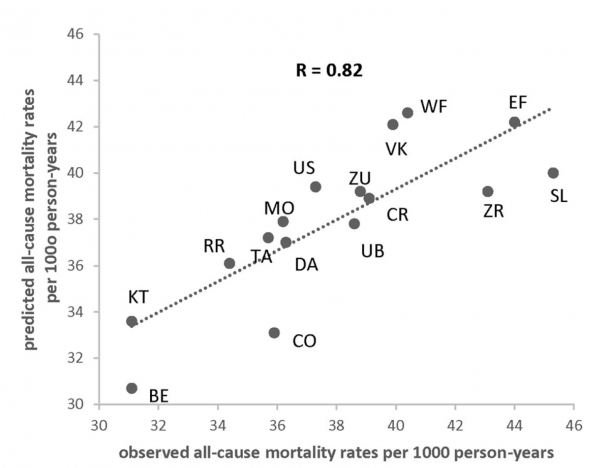Cross-cultural associations:
Average intake of fatty acids, food groups and 50-year all-cause mortality rates in 16 cohorts
In the 1960s the average population intake of saturated (S), and trans fats (T) and hard fats (butter, lard, and hard margarine) was high in northern Europe while monounsaturated (M), polyunsaturated (P) fatty acids, and vegetable oils (mostly olive oil) were high in Mediterranean areas and total fat was low in Japan. The all-cause mortality rate was lowest in rural Crete and highest in rural East Finland.
The 50-year all-cause mortality rates were correlated (R= -0.68 to -0.77) ecologically inversely with the ratios M/S, (M+P)/(S+T), and hard fats/vegetable oils. The strongest correlation (R=-0.82) of the observed and predicted death rates was a function of the (M+P)/(S+T) ratio. The (M+P)/(S+T) ratio reflects the degree of resemblance to a classic “Mediterranean Diet.”

Observed and predicted death rates as a function of (M+P)/(S+T) ratio adjusted for higher SES for the 16 cohorts in the Seven Countries Study. SES: socio-economic status; US: US railroad; EF: East Finland; WF: West Finland, ZU: Zutphen, the Netherlands; CR: Crevalcore, Italy; MO: Montegiorgio, Italy; RR: Rome railroad, Italy; DA: Dalmatia, Croatia; SL: Slavonia, Croatia; VK: Velika Krsna, Serbia; ZR: Zrenjanin, Serbia; BE: Belgrade, Serbia; KT: Crete, Greece; CO: Corfu, Greece; TA: Tanushimaru, Japan; UB: Ushibuka, Japan
Interpretation
Both saturated and polyunsaturated fatty acids in % energy, and the P/S ratio, were popular indices in the 1960s. Keys and colleagues showed in 1986, in an ecological analysis of the Seven Countries Study, that the Monounsaturated/Saturated fatty acids ratio was inversely related to 15-year all-cause mortality rates. Dietary intervention studies showed that mono- and polyunsaturated fatty acids decrease LDL-cholesterol when substituted for saturated and trans fatty acids. Based on these results it may be expected that raising the ratio of (M+P)/(S+T) will be associated with lower all-cause mortality.
